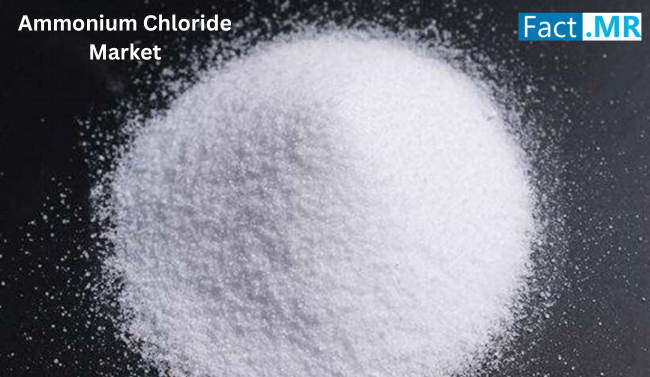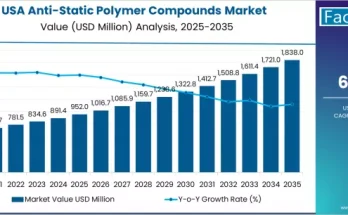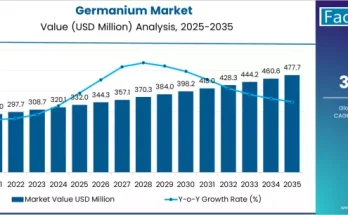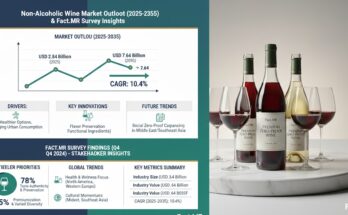The Ammonium Chloride Market is experiencing steady global growth, fueled by its wide-ranging applications across agriculture, pharmaceuticals, food processing, textiles, and industrial manufacturing. In 2023, the market was valued at around USD 1.4 billion, and projections indicate it will surpass USD 2.1 billion by 2033, reflecting a CAGR of approximately 4.1%. This growth is rooted in rising food production demands, expanding industrial usage, and increasing interest in specialty chemical applications.
As governments and industries push toward sustainability and modernization, ammonium chloride is becoming a critical player in the global chemical landscape.
Key Market Segments
- By Grade
The market is segmented into various grades—agricultural, industrial, food-grade, and pharmaceutical-grade.
- Agricultural-grade ammonium chloride holds the largest share, primarily used as a nitrogen source in fertilizers. It is especially effective in rice and wheat cultivation due to its acidity and slow-release characteristics.
- Industrial-grade is widely used in galvanizing, metal fluxes, battery electrolytes, leather tanning, and textile processing.
- Food-grade ammonium chloride is used as a flavoring agent, mainly in bakery and confectionery products.
- Pharmaceutical-grade ammonium chloride is used in expectorants, cough syrups, and medications for treating alkalosis.
The food and pharmaceutical grades are witnessing faster growth rates due to increasing demand for quality ingredients and healthcare solutions in both developed and emerging economies.
- By Form
- Solid ammonium chloride dominates the market due to its stability, ease of transport, and longer shelf life. It is the preferred form in fertilizers and industrial uses.
- Liquid ammonium chloride, though a smaller segment, is gaining traction in electronics manufacturing and pharmaceutical applications where precision and purity are critical.
Application Insights
- Fertilizers
Fertilizer remains the leading application for ammonium chloride, particularly in Asia-Pacific countries where rice is a staple crop. The chemical serves as a low-cost and efficient nitrogen source, improving crop yields and soil pH in specific conditions.
- Pharmaceuticals
The pharmaceutical industry uses ammonium chloride for its expectorant and diuretic properties. With the rise in global health awareness and growing demand for over-the-counter remedies, pharmaceutical-grade ammonium chloride is seeing increased adoption.
- Food & Beverage
As consumer preferences shift toward clean-label and functional food products, food-grade ammonium chloride is used as a flavor enhancer in bakery, liquorice-based candies, and beverages. Its role as a leavening agent also supports its adoption in commercial baking.
- Industrial Manufacturing
Industrial applications span galvanization, textiles, leather treatment, dye production, and batteries. Its role as a fluxing agent in metalwork and as an electrolyte in dry-cell batteries supports a steady demand in heavy industry and electronics manufacturing.
Regional Overview
Asia-Pacific
Asia-Pacific leads the global ammonium chloride market with over half the global consumption. This dominance is driven by large-scale agriculture in China, India, and Southeast Asia, where ammonium chloride is widely used as a cost-effective fertilizer. In addition, the region houses several large-scale chemical manufacturers who utilize ammonium chloride as an intermediate.
North America
North America is seeing robust demand, especially in industrial applications and food-grade uses. The growing trend of processed and packaged foods, along with increased pharmaceutical consumption, supports continued growth.
Europe
Europe’s market is growing steadily, especially in food and specialty chemical applications. With a focus on sustainability and regulatory compliance, European manufacturers are adopting high-purity grades and eco-friendly production methods.
Latin America, Middle East & Africa
These regions present emerging opportunities for growth. Agricultural modernization in Latin America and industrial development across parts of Africa and the Middle East are increasing the need for affordable nitrogen fertilizers and industrial chemicals.
Industry Trends and Developments
- Sustainable Production
As environmental regulations tighten, manufacturers are shifting toward cleaner production processes and better waste management techniques. Efforts are underway to reduce energy consumption and carbon emissions during ammonium chloride production, especially when produced as a by-product of soda ash manufacturing.
- Product Innovation
Innovation in purity levels and specialized formulations is gaining momentum. Ultra-pure ammonium chloride is now being used in electronics, semiconductors, and high-end pharmaceutical processes.
- Expansion in Emerging Economies
Growing populations and food security concerns are pushing governments to invest in crop enhancement and modern farming practices. This, in turn, increases the demand for effective nitrogen sources like ammonium chloride.
- Digital Supply Chains
To counter volatility in raw material prices and transportation challenges, companies are investing in digital logistics, real-time inventory tracking, and smart procurement strategies to streamline supply chains and reduce costs.
Market Challenges
Despite its growth potential, the ammonium chloride market faces several challenges:
- Competition from substitutes: Urea and ammonium sulfate are sometimes preferred due to regional price advantages or specific crop requirements.
- Environmental concerns: Overuse of chloride-containing fertilizers can lead to soil salinization, limiting long-term agricultural use in sensitive regions.
- Raw material volatility: Prices of key feedstocks like ammonia and hydrochloric acid can impact production economics and margins.
Manufacturers must innovate, diversify product offerings, and adopt sustainable practices to stay competitive.
Strategic Outlook
Looking ahead to 2035, the ammonium chloride market is positioned for consistent growth. Companies that invest in:
- High-purity, value-added products
- Sustainable production and packaging
- Geographic expansion into untapped agricultural and industrial regions
- Integration with global food and health supply chains
will gain a competitive edge in this evolving space.
Conclusion
The global ammonium chloride market presents a strong value proposition for stakeholders across agriculture, food, pharmaceuticals, and industry. With its reliable performance, cost-efficiency, and adaptability to a wide range of applications, ammonium chloride continues to be a key component in meeting the demands of a growing and industrializing world.
As market dynamics shift toward sustainability, specialization, and regional diversification, ammonium chloride is well-positioned to thrive—supporting both economic growth and societal needs in the years to come.



